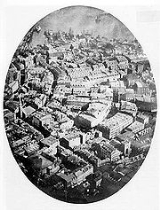
Aerial reconnaissance
Encyclopedia

Reconnaissance
Reconnaissance is the military term for exploring beyond the area occupied by friendly forces to gain information about enemy forces or features of the environment....
that is conducted using unmanned aerial vehicle
Unmanned aerial vehicle
An unmanned aerial vehicle , also known as a unmanned aircraft system , remotely piloted aircraft or unmanned aircraft, is a machine which functions either by the remote control of a navigator or pilot or autonomously, that is, as a self-directing entity...
s or reconnaissance aircraft
Reconnaissance aircraft
A reconnaissance aircraft is a manned military aircraft designed, or adapted, to carry out aerial reconnaissance.-History:The majority of World War I aircraft were reconnaissance designs...
. Their roles are to collect imagery intelligence, signals intelligence and measurement and signature intelligence
Measurement and Signature Intelligence
Measurement and signature intelligence is a branch of intelligence gathering activities.MASINT, may have aspects of intelligence analysis management, since certain aspects of MASINT, such as the analysis of electromagnetic radiation received by signals intelligence are more of an analysis...
.
Pre World War I
After the French RevolutionFrench Revolution
The French Revolution , sometimes distinguished as the 'Great French Revolution' , was a period of radical social and political upheaval in France and Europe. The absolute monarchy that had ruled France for centuries collapsed in three years...
, the new rulers became interested in using the balloon
Balloon (aircraft)
A balloon is a type of aircraft that remains aloft due to its buoyancy. A balloon travels by moving with the wind. It is distinct from an airship, which is a buoyant aircraft that can be propelled through the air in a controlled manner....
to observe enemy manoeuvres and appointed scientist Charles Coutelle
Jean-Marie-Joseph Coutelle
Jean-Marie-Joseph Coutelle was a French engineer, scientist and pioneer of ballooning.-Life:...
to conduct studies using the balloon L'Entreprenant, the first military reconnaissance aircraft. The balloon found its first use in the 1794 conflict with Austria
French Revolutionary Wars: Campaigns of 1794
The French Revolutionary Wars continued from 1793 with few immediate changes in the diplomatic situation as France fought the First coalition.On the Alpine frontier, there was little change, with the French invasion of Piedmont failing...
, where in the Battle of Fleurus
Battle of Fleurus (1794)
In the Battle of Fleurus on 26 June 1794, the army of the First French Republic under General Jean-Baptiste Jourdan faced the Coalition Army commanded by Prince Josias of Coburg in the most decisive battle of the Flanders Campaign in the Low Countries during the French Revolutionary Wars...
the gathered information and the demoralizing effect on the Austrian troops ensured victory for the French troops.
After the invention of photography, primitive aerial photographs were made of the ground from manned and unmanned balloons, starting in the 1860s, and from tethered kites from the 1880s onwards. An example was Arthur Batut
Arthur Batut
Arthur Batut was a French photographer and pioneer of aerial photography.-Life:Batut, born 1846 in Castres, was interested in history, archeology and photography...
's kite-borne camera photographs of Labruguière
Labruguière
Labruguière is a commune in the Tarn department in southern France.-Geography:The Thoré forms part of the commune's eastern border, flows north-northwestward through the northern part of the commune, crosses the village, then forms part of its northern border.-References:*...
starting from 1889.
In the early 20th century, Julius Neubronner
Julius Neubronner
Julius Gustav Neubronner was a German apothecary, inventor, company founder, and a pioneer of amateur photography and film. He was part of a dynasty of apothecaries in Kronberg im Taunus...
experimented with pigeon photography.
The pigeons carried small cameras with timers.
Ludwig Rahrmann in 1891 patented a means of attaching a camera to a large calibre artillery projectile or rocket, and this inspired Alfred Maul
Alfred Maul
Alfred Maul was a German engineer who could be thought of as the father of aerial reconnaissance. Maul, who owned a machine works, experimented from 1900 with small solid-propellant sounding rockets.-Background:...
to develop his Maul Camera Rocket
Maul Camera Rocket
The Maul Camera Rocket was a rocket for aerial photography developed by Alfred Maul's company from 1903 to 1912. The Maul Camera Rocket was demonstrated in 1912 to the Austrian Army and tested as a means for reconnaissance in the Turkish-Bulgarian War in 1912/1913...
s starting in 1903. Alfred Nobel
Alfred Nobel
Alfred Bernhard Nobel was a Swedish chemist, engineer, innovator, and armaments manufacturer. He is the inventor of dynamite. Nobel also owned Bofors, which he had redirected from its previous role as primarily an iron and steel producer to a major manufacturer of cannon and other armaments...
in 1896 had already built the first rocket carrying a camera, which took photographs of the Swedish landscape during its flights. Maul improved his camera rockets and the Austrian Army even tested them in the Turkish-Bulgarian War
Balkan Wars
The Balkan Wars were two conflicts that took place in the Balkans in south-eastern Europe in 1912 and 1913.By the early 20th century, Montenegro, Bulgaria, Greece and Serbia, the countries of the Balkan League, had achieved their independence from the Ottoman Empire, but large parts of their ethnic...
in 1912 and 1913, but by then and from that time on camera-carrying aircraft were found to be superior.
The first use of airplanes in combat missions was by the Italian Air Force
Italian Air Force
The Italian Air Force has gone under different names in different periods:*Regia Aeronautica , from 1923 to June 1946*Aeronautica Nazionale Repubblicana, the air force of Italian Social Republic during World War II...
during the Italo-Turkish War
Italo-Turkish War
The Italo-Turkish or Turco-Italian War was fought between the Ottoman Empire and the Kingdom of Italy from September 29, 1911 to October 18, 1912.As a result of this conflict, Italy was awarded the Ottoman provinces of Tripolitania, Fezzan, and...
of 1911-1912. On 23 October 1911, an Italian pilot flew over the Turkish lines in Libya
Libya
Libya is an African country in the Maghreb region of North Africa bordered by the Mediterranean Sea to the north, Egypt to the east, Sudan to the southeast, Chad and Niger to the south, and Algeria and Tunisia to the west....
to conduct history's first aerial reconnaissance mission, and on 1 November 1911, the first ever aerial bomb was dropped on the Turkish troops in Libya.
On 16 October 1912 a Bulgaria
Bulgaria
Bulgaria , officially the Republic of Bulgaria , is a parliamentary democracy within a unitary constitutional republic in Southeast Europe. The country borders Romania to the north, Serbia and Macedonia to the west, Greece and Turkey to the south, as well as the Black Sea to the east...
n Albatros aircraft was used to perform Europe's first reconnaissance flight in combat conditions, against the Turkish lines on the Balkan peninsula, during the Balkan Wars
Balkan Wars
The Balkan Wars were two conflicts that took place in the Balkans in south-eastern Europe in 1912 and 1913.By the early 20th century, Montenegro, Bulgaria, Greece and Serbia, the countries of the Balkan League, had achieved their independence from the Ottoman Empire, but large parts of their ethnic...
of 1912-1913.
World War I and World War II
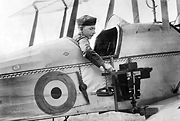
World War I
World War I , which was predominantly called the World War or the Great War from its occurrence until 1939, and the First World War or World War I thereafter, was a major war centred in Europe that began on 28 July 1914 and lasted until 11 November 1918...
, photo-reconnaissance, now called IMINT
IMINT
Imagery Intelligence , is an intelligence gathering discipline which collects information via satellite and aerial photography. As a means of collecting intelligence, IMINT is a subset of intelligence collection management, which, in turn, is a subset of intelligence cycle management...
, was one of the early uses of the aeroplane. Aviators such as Fred Zinn
Fred Zinn
Friedrich Wilhelm "Fred" Zinn was a volunteer American aviator who flew with French Armée de l'Air forces in World War I and an early pioneer of aerial photography for wartime reconnaissance and Military intelligence....
evolved an entire range of new flying and photography techniques to use the new technology in the equally new environment of trench warfare
Trench warfare
Trench warfare is a form of occupied fighting lines, consisting largely of trenches, in which troops are largely immune to the enemy's small arms fire and are substantially sheltered from artillery...
.
Before the Second World War the conventional wisdom was to use converted bomber
Bomber
A bomber is a military aircraft designed to attack ground and sea targets, by dropping bombs on them, or – in recent years – by launching cruise missiles at them.-Classifications of bombers:...
types for airborne photo-reconnaissance. These bombers retained their defensive armament, which was vital since they were unable to avoid interception. Later it was found that day bombers required a fighter escort.
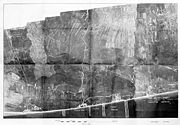
Sidney Cotton
Frederick Sidney Cotton OBE was an Australian inventor, photographer and aviation and photography pioneer, responsible for developing and promoting an early colour film process, and largely responsible for the development of photographic reconnaissance before and during the Second World War...
and Flying Officer
Flying Officer
Flying officer is a junior commissioned rank in the Royal Air Force and the air forces of many countries which have historical British influence...
Maurice Longbottom of the RAF
Royal Air Force
The Royal Air Force is the aerial warfare service branch of the British Armed Forces. Formed on 1 April 1918, it is the oldest independent air force in the world...
were among the first to suggest that airborne reconnaissance may be a task better suited to fast, small aircraft which would use their speed and high service ceiling to avoid detection and interception. Although this seems obvious now, with modern reconnaissance tasks performed by fast, high flying aircraft, at the time it was radical thinking. They proposed the use of Spitfires
Supermarine Spitfire
The Supermarine Spitfire is a British single-seat fighter aircraft that was used by the Royal Air Force and many other Allied countries throughout the Second World War. The Spitfire continued to be used as a front line fighter and in secondary roles into the 1950s...
with their armament and radio
Radio
Radio is the transmission of signals through free space by modulation of electromagnetic waves with frequencies below those of visible light. Electromagnetic radiation travels by means of oscillating electromagnetic fields that pass through the air and the vacuum of space...
s removed and replaced with extra fuel and cameras. This led to the development of the Spitfire PR variants. Spitfires proved to be extremely successful in their reconnaissance role and there were many variants built specifically for that purpose. They served initially with what later became No. 1 Photographic Reconnaissance Unit
No. 1 Photographic Reconnaissance Unit RAF
No. 1 Photographic Reconnaissance Unit was a flying unit of the Royal Air Force, first formed in 1940.-History:The origins of 1 PRU date to the "Heston Flight" formed on 24 September 1939, when the Royal Air Force took over Sidney Cotton's Aircraft Operating Company, based at Heston Aerodrome...
(PRU).
During World War II
World War II
World War II, or the Second World War , was a global conflict lasting from 1939 to 1945, involving most of the world's nations—including all of the great powers—eventually forming two opposing military alliances: the Allies and the Axis...
, fighters
Fighter aircraft
A fighter aircraft is a military aircraft designed primarily for air-to-air combat with other aircraft, as opposed to a bomber, which is designed primarily to attack ground targets...
such as the British Spitfire
Supermarine Spitfire
The Supermarine Spitfire is a British single-seat fighter aircraft that was used by the Royal Air Force and many other Allied countries throughout the Second World War. The Spitfire continued to be used as a front line fighter and in secondary roles into the 1950s...
and Mosquito
De Havilland Mosquito
The de Havilland DH.98 Mosquito was a British multi-role combat aircraft that served during the Second World War and the postwar era. It was known affectionately as the "Mossie" to its crews and was also nicknamed "The Wooden Wonder"...
and the American P-38 Lightning
P-38 Lightning
The Lockheed P-38 Lightning was a World War II American fighter aircraft built by Lockheed. Developed to a United States Army Air Corps requirement, the P-38 had distinctive twin booms and a single, central nacelle containing the cockpit and armament...
and P-51 Mustang
P-51 Mustang
The North American Aviation P-51 Mustang was an American long-range, single-seat fighter and fighter-bomber used during World War II, the Korean War and in several other conflicts...
were adapted for photo-reconnaissance. Such craft were stripped of weaponry, painted in sky camouflage colours to make them difficult to spot in the air, and often had engines modified for higher performance at very high altitudes (well over 40,000 feet). Early in the war the British developed a camera warming system to allow photographs to be taken at very high altitudes. Based at RAF Medmenham
RAF Medmenham
RAF Medmenham was a Royal Air Force station based at Danesfield House near Medmenham, in Buckinghamshire, England.Activities there specialized in photographic intelligence, and it was once the home of the RAF Intelligence Branch...
, the collection and interpretation of such photographs became a considerable enterprise. One site claims that the British, at their peak, flew over 100 reconnaissance flights a day, yielding 50,000 images per day to interpret. Similar efforts were taken by other countries.
The Japanese Mitsubishi Ki-46
Mitsubishi Ki-46
The Mitsubishi Ki-46 was a twin-engine reconnaissance aircraft used by the Imperial Japanese Army in World War II. Its Army Shiki designation was Type 100 Command Reconnaissance Aircraft ; the Allied nickname was "Dinah"....
, a purpose-built twin-engined reconnaissance aircraft armed with only one light gun, entered service in 1941.
The reconnaissance plane that had the earliest and greatest influence for the Americans in WWII was the F-4, a factory modification of the P-38E
P-38 Lightning
The Lockheed P-38 Lightning was a World War II American fighter aircraft built by Lockheed. Developed to a United States Army Air Corps requirement, the P-38 had distinctive twin booms and a single, central nacelle containing the cockpit and armament...
which replaced the four guns and cannon with four high-quality K-17 cameras. Some 120 F-4 and F-4As were hurriedly made available by March 1942, reaching the 8th Photographic Squadron in Australia by April (the first P-38s to see action). The F-4 had an early advantage of long range and high speed combined with the ability to fly at high altitude; a potent combination for reconnaissance. In the last half of 1942, Lockheed would produce 96 F-5As, based on the P-38G. The Lightning in its reconnaissance role was so well liked by military strategists that hundreds of gun-equipped P-38s were field modified into camera-toting F-5 variants. Later in the war, the Mustang F-6
P-51 Mustang
The North American Aviation P-51 Mustang was an American long-range, single-seat fighter and fighter-bomber used during World War II, the Korean War and in several other conflicts...
arrived, eventually becoming the dominant reconnaissance model flown by the US in Europe. US photo-reconnaissance operations in Europe were based at RAF Mount Farm
RAF Mount Farm
RAF Mount Farm is a former World War II airfield in England. The field is located three miles north of Dorchester, Oxfordshire.-USAAF use:Mount Farm was originally a satellite airfield for the RAF Photographic Reconnaissance Unit at RAF Benson. The airfield was originally a grass field, but...
, with the resulting photographs being transferred to Medmenham for interpretation.
However it was the Mosquito that excelled in the photo-reconnaissance role, the converted bomber being given three cameras installed in what had been the bomb bay. The first converted PRU (Photo-Reconnaissance Unit) Mosquito being delivered to RAF Benson
RAF Benson
RAF Benson is a Royal Air Force station near Benson in South Oxfordshire, England. It is home to the Royal Air Force's support helicopters, the Aérospatiale Puma and the EH-101 Merlin, known as the Puma HC.Mk 1 and the Merlin HC.Mk 3 and Mk 3a....
in July 1941 by Geoffrey de Havilland himself. Thereafter, the Mosquito was faster than most fighters above 40,000ft, and could roam almost anywhere. Colonel Roy M. Stanley II, USAF (RET) wrote; "I consider the Mosquito the best photo reconnaissance aircraft of the war". The US designation for the photo-reconnaissance Mosquito was F-8.
Approximately 15,000 Fairchild K-20
Fairchild K-20
The K-20 is an aerial camera used during World War II. Fairchild design, made under licence for military contract. Approximately 15,000 were manufactured by Folmer Graflex Corp. in Rochester, NY between 1941-1945. They use a 5.25"x20 to 5.25"x200 foot Roll Film, with an image size of 4x5 inches...
aerial cameras were manufactured between 1941 and 1945.
Cold War
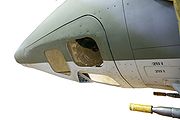
English Electric Canberra
The English Electric Canberra is a first-generation jet-powered light bomber manufactured in large numbers through the 1950s. The Canberra could fly at a higher altitude than any other bomber through the 1950s and set a world altitude record of 70,310 ft in 1957...
, and its American development, the Martin B-57 – capable of flying higher or faster than the enemy. After the Korean War
Korean War
The Korean War was a conventional war between South Korea, supported by the United Nations, and North Korea, supported by the People's Republic of China , with military material aid from the Soviet Union...
, RB-47 aircraft were used. These were at first converted B-47 jet bombers, but later these were purposely built RB-47 reconnaissance planes. They did not carry any bombs. They had large cameras mounted in the belly of the plane, and with a truncated bomb bay used for carrying photo-flash
Flash (photography)
A flash is a device used in photography producing a flash of artificial light at a color temperature of about 5500 K to help illuminate a scene. A major purpose of a flash is to illuminate a dark scene. Other uses are capturing quickly moving objects or changing the quality of light...
bombs.
The onset of the Cold War
Cold War
The Cold War was the continuing state from roughly 1946 to 1991 of political conflict, military tension, proxy wars, and economic competition between the Communist World—primarily the Soviet Union and its satellite states and allies—and the powers of the Western world, primarily the United States...
led the development of highly specialized and secretive strategic reconnaissance aircraft, or spy planes, such as the Lockheed U-2
Lockheed U-2
The Lockheed U-2, nicknamed "Dragon Lady", is a single-engine, very high-altitude reconnaissance aircraft operated by the United States Air Force and previously flown by the Central Intelligence Agency . It provides day and night, very high-altitude , all-weather intelligence gathering...
and its successor, the SR-71 Blackbird
SR-71 Blackbird
The Lockheed SR-71 "Blackbird" was an advanced, long-range, Mach 3+ strategic reconnaissance aircraft. It was developed as a black project from the Lockheed A-12 reconnaissance aircraft in the 1960s by the Lockheed Skunk Works. Clarence "Kelly" Johnson was responsible for many of the...
(both from the United States
United States
The United States of America is a federal constitutional republic comprising fifty states and a federal district...
). Flying these aircraft became an exceptionally demanding task, as much because of the aircraft's extreme speed and altitude as it was because of the risk of being captured as spies
SPY
SPY is a three-letter acronym that may refer to:* SPY , ticker symbol for Standard & Poor's Depositary Receipts* SPY , a satirical monthly, trademarked all-caps* SPY , airport code for San Pédro, Côte d'Ivoire...
. As a result, the crews of these aircraft were invariably specially selected and trained.
There are claims that the US constructed a hypersonic
Hypersonic
In aerodynamics, a hypersonic speed is one that is highly supersonic. Since the 1970s, the term has generally been assumed to refer to speeds of Mach 5 and above...
reconnaissance aircraft, dubbed the Aurora, in the late 1980s to replace the Blackbird.
Since the early 1960s, in the United States aerial and satellite reconnaissance has been coordinated by the National Reconnaissance Office
National Reconnaissance Office
The National Reconnaissance Office , located in Chantilly, Virginia, is one of the 16 U.S. intelligence agencies. It designs, builds, and operates the spy satellites of the United States government.-Mission:...
.
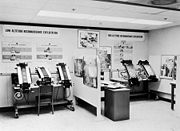 |
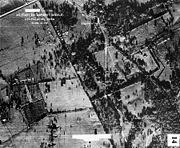 |
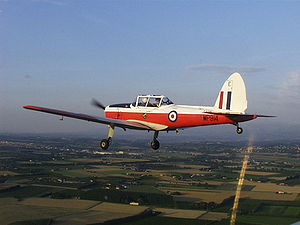 |
Modern era
In 2001, in what became known as the Hainan Island incidentHainan Island incident
On April 1, 2001, a mid-air collision between a United States Navy EP-3E ARIES II signals intelligence aircraft and a People's Liberation Army Navy J-8II interceptor fighter jet resulted in an international dispute between the United States and the People's Republic of China called the Hainan...
, a Chinese interceptor collided with a US Navy EP-3 Orion on a signals reconnaissance mission. The crew of the larger US aircraft made an emergency landing. The aircraft and crew were later released by the Chinese authorities.
Drone planes
- MQ-9 ReaperMQ-9 ReaperThe General Atomics MQ-9 Reaper is an unmanned aerial vehicle , capable of remote controlled or autonomous flight operations, developed by General Atomics Aeronautical Systems for use by the United States Air Force, the United States Navy, the CIA, U.S. Customs and Border Protection, the Royal...
The cameras that the drones carry are capable of identifying an object the size of a milk carton from altitudes of 60,000 feet. - RQ-4 Global HawkRQ-4 Global HawkThe Northrop Grumman RQ-4 Global Hawk is an unmanned aerial vehicle used by the United States Air Force and Navy as a surveillance aircraft....
Miniature UAVs
- AeroVironment Wasp III (airplane - electric propulsion)
- Aeryon Scout (VTOL Rotorcraft) - Some UAVs are small enough to carry in a backpack with similar functionality to larger ones
- EMT Aladin (aircraft - electric - Made in Germany)
Reconnaissance pods
Reconnaissance pods can be carried by fighter-bomber aircraft. Examples include the British DJRP, the Chinese KZ900KZ900
The KZ900 reconnaissance pod is an airborne SIGINT pod, used by the Chinese Military, that was first revealed to the public at 1998 Zhuhai Air Show, and it is designed by Southwestern Institute of Electrical and Electronics at Chengdu....
, the US RAPTOR
RAPTOR
RAPTOR is a reconnaissance pod used by the Royal Air Force on its fleet of Tornado GR.4A and GR.4 aircraft. RAPTOR is manufactured by the Goodrich Corporation....
and the US TARPS
Tactical Airborne Reconnaissance Pod System
The Tactical Airborne Reconnaissance Pod System is a large and sophisticated camera pod carried by the F-14 Tomcat. It contains three camera bays with different type cameras which are pointed down at passing terrain. It was originally designed to provide an interim reconnaissance capability until...
.
See also
- Aerial photographyAerial photographyAerial photography is the taking of photographs of the ground from an elevated position. The term usually refers to images in which the camera is not supported by a ground-based structure. Cameras may be hand held or mounted, and photographs may be taken by a photographer, triggered remotely or...
- Heterogeneous Aerial Reconnaissance TeamHeterogeneous Aerial Reconnaissance TeamThe Heterogeneous Aerial Reconnaissance Team -- formerly known as the "Heterogeneous Urban RSTA Team " -- program was an aerial surveillance project funded by the Information Processing Technology Office of the Defense Advanced Research Projects Agency...
- Project Genetrix
- Surveillance aircraftSurveillance aircraftA surveillance aircraft is an aircraft used for surveillance — collecting information over time. They are operated by military forces and other government agencies in roles such as intelligence gathering, battlefield surveillance, airspace surveillance, observation , border patrol and fishery...
- Space reconnaissance
- Thaddeus Lowe
- United States aerial reconnaissance of the Soviet Union
External links
- National Collection of Aerial Photography The official archive of British Government declassified aerial photography.

